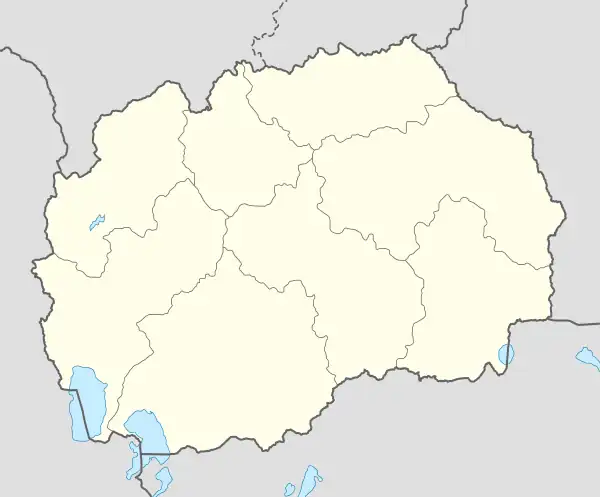Gorna Banjica
Горна Бањица Banjicë e Epërme Yukarı Banisa | |
|---|---|
Village | |
 Gorna Banjica Location within North Macedonia | |
| Coordinates: 41°47′N 20°54′E / 41.783°N 20.900°E | |
| Country | |
| Region | |
| Municipality | |
| Population (2002) | |
| • Total | 4,423 |
| Time zone | UTC+1 (CET) |
| • Summer (DST) | UTC+2 (CEST) |
| Car plates | GV |
| Website | . |
Gorna Banjica (Macedonian: Горна Бањица, Turkish: Yukarı Banisa, Albanian: Banjicë e Epërme) is a village in the municipality of Gostivar, North Macedonia.
History
According to the 1467-68 Ottoman defter, the village had 17 houses, with the inhabitants having a mixed Slavic-Albanian anthroponymy - usually a Slavic first name and an Albanian last name or last names with Albanian patronyms and Slavic suffixes, (e.g Nikolla Arbanas (t.Arnaut); Progon, son of Tanush; Jovan,son of Prenk).[1]
A policy of Turkification of the Albanian population was employed by the Yugoslav authorities in cooperation with the Turkish government, stretching the period of 1948-1959. Starting in 1948, Turkish schools were opened in areas with large Albanian majorities, such as Gorna Banjica.[2]
Demographics
According to the 1942 Albanian census, Gorna Banjica was inhabited by 854 Muslim Albanians, 35 Serbs and 11 Bulgarians.[3]
The Yugoslav census of 1953 recorded 1,072 people of whom 754 were Albanians, 240 Turks, 73 Macedonians and 5 others. The 1961 Yugoslav census recorded 1,108 people of whom 212 were Albanians, 827 Turks, 68 Macedonians and 1 others. The 1971 census recorded 1,267 people of whom 239 were Albanians, 1,003 Turks and 25 Macedonians. The 1981 Yugoslav census recorded 1,611 people of whom 474 were Albanians, 7 Macedonians, 1,118 Turks, 1 Bosniak and 11 others. The Macedonian census of 1994 recorded 1,622 people of whom 422 were Albanians, 1,239 Turks and 1 other.[4]
According to the 2002 census, the village had a total of 4,423 inhabitants.[5] Ethnic groups in the village include:[5]
- Albanians 1,636
- Turks 1,243
- Macedonians 1,196
- Romani 315
- Serbs 4
- Others 29
As of the 2021 census, Gorna Banjica had 3,436 residents with the following ethnic composition:[6]
- Turks 1,503
- Macedonians 839
- Albanians 811
- Roma 610
- Persons for whom data are taken from administrative sources 107
- Others 16
References
- ↑ Rexha, Iljaz (2011). "Vendbanimet dhe popullsia albane gjatë mesjetës në hapësirën e Maqedonisë së sotme: Sipas burimeve sllave dhe osmane". Gjurmime Albanologjike: Seria e Shkencave Historike (41–42): 115. The names are: Nikolla Arbanas (t.Arnaut); Progon, son of Tanush; Jovan,son of Prenk; Todori, son of Tono; Pron-ko, son of Rale; Marin, son of Stojko; Nik-o Dibrani; Kol-in, son of Bojk-a; Gjon, son of Nikolla; Jovan, son of Nikolla; Vasil, son of Nikolla; Stepan, son of Nikolla; Todori, son of Nikola; Niko, son of Kola; Cvetko, son of Kola; Koljo Domazet; Dimitri, his son.
- ↑ Lita, Qerim (2009). "SHPËRNGULJA E SHQIPTARËVE NGA MAQEDONIA NË TURQI (1953-1959)". Studime Albanologjike. ITSH: 75-82.
- ↑ http://pop-stat.mashke.org/alb-historic/1942-diber-tetove-ethnicrel-loc.htm
- ↑ Sherafedin Kaso (2005). The settlements with Muslim population in Macedonia. Logos-A. p. 24. ISBN 978-9989-58-155-7.
- 1 2 Macedonian Census (2002), Book 5 - Total population according to the Ethnic Affiliation, Mother Tongue and Religion, The State Statistical Office, Skopje, 2002, p. 96.
- ↑ Total resident population of the Republic of North Macedonia by ethnic affiliation, by settlement, Census 2021
External links